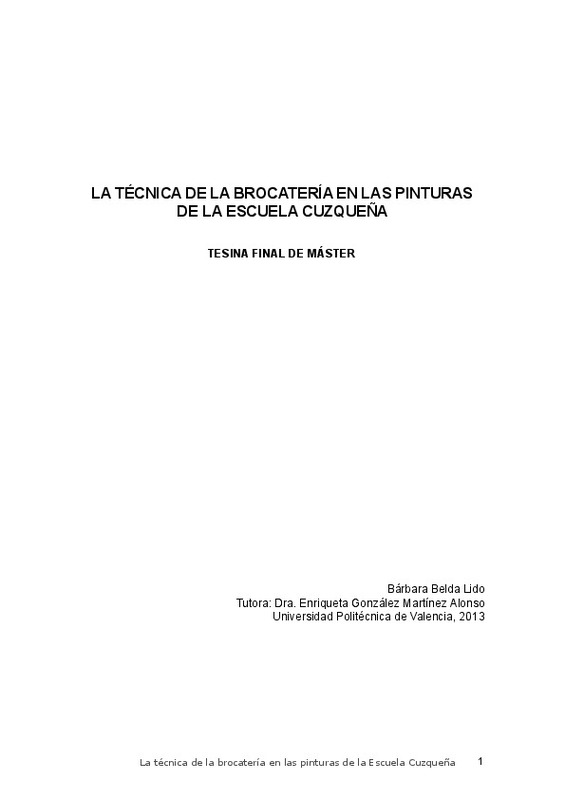JavaScript is disabled for your browser. Some features of this site may not work without it.
Buscar en RiuNet
Listar
Mi cuenta
Estadísticas
Ayuda RiuNet
Admin. UPV
La técnica de la brocatería en las pinturas de la escuela cuzqueña
Mostrar el registro sencillo del ítem
Ficheros en el ítem
| dc.contributor.advisor | Gonzalez Martinez, Enriqueta
|
es_ES |
| dc.contributor.author | Belda Lido, Bárbara
|
es_ES |
| dc.date.accessioned | 2014-09-10T11:37:17Z | |
| dc.date.available | 2014-09-10T11:37:17Z | |
| dc.date.created | 2013-09-10 | |
| dc.date.issued | 2014-09-10T11:37:17Z | |
| dc.identifier.uri | http://hdl.handle.net/10251/39559 | |
| dc.description.abstract | [EN] The origins of the Cusco School has its roots in two magnificent cultures like the spanish culture and the peruvian culture. This blend is present in the rich paintings that were given birth by the Cusco School. The first paintings from the Cusco School date back from the 16th century in the city of Cusco, and they have a special peak of importance during the 17th and 18th century. This painting style, which is still conserved to some extent in our days, is characterized by the blend of styles coming from Europe and the artistic vocation of pre-Columbian civilizations. However, the main trait of the Cusco School is the painting technique known as brocade, which consists of decorating canvas by means of gold dust. The goal of this technique is highlighting the magnificence of the image portraited in the painting. The main goal of this thesis is determining the brocade methodology, the materials, and the tools used by masters of the Cusco School. The research methodology carried out in this thesis is both theoretical and experimental. For this matter, two different studies were carried out. Firstly, different tests were designed to determine the thickening agent employed by Cusco masters in conjunction with gold dust. Additionally, we evaluated the behaviour and effect of the thickening agent on the canvas and its ease of manipulation. Lastly, we tested different hypothesis for the brocade method employed by the Cusco School: the template system, the mark system, the piped systems, the rubber bulb system, and the brush system. We evaluated the results by comparison with original canvas from the Cusco School. On the one hand, the results of the experiments show that the benjui resin is the most likely thickening used by the Cusco School. On the other hand, from the brocade techniques that we explored, the experiments suggest the mix of template and brush techniques as the most likely method used by masters of the Cusco School | es_ES |
| dc.description.abstract | [ES] La Escuela Cuzqueña proviene de la unión de dos grandes culturas y la fusión de dos países como son Perú y España; derivando en un mestizaje que se plasmaría en su pintura. La pintura cuzqueña o cusqueña aparece en la ciudad de Cuzco en el siglo XVI y transcurre durante los siglos XVII y XVIII con gran apogeo. Dicha vertiente artística que se conserva aun en nuestros días en menor medida, se caracteriza notoriamente por la mezcla de estilos y técnicas provenientes de Europa y la vocación artística de los precolombinos que destacan por el empleo de la técnica denominada brocatería o brocateado, que consiste en la ornamentación posterior, mediante oro en polvo, sobre los lienzos cuzqueños con el fin de resaltar el máximo esplendor. El principal objetivo de este trabajo es determinar a través de una investigación teórica y práctica, la posible metodología que emplearon los antiguos maestros de la Escuela Cuzqueña para la ejecución de la brocatería, así como determinar los materiales y herramientas de uso. Para esclarecer esta investigación se han elaborado un conjunto de probetas: - En primer lugar, se ha estudiado el aglutinante empleado en el oro en polvo, así como la evaluación de su comportamiento y efectividad sobre el soporte de tela y la dificultad de su manipulación. Los aglutinantes seleccionados han sido: laca Zapón, goma arábiga, cola de pescado, adhesivo nitrocelulósico, Decorfin, resina sandáraca, resina dammar, resina de benjuí y resina de almáciga. - Y en segundo lugar, nos hemos planteado una serie de suposiciones sobre el método de ejecución de la brocatería, estableciéndo como hipótesis los métodos por sistema de plantilla, por sistema de cuño, método de entubado o a pincel a mano alzada. Efectuadas estas probetas se procedió a la evaluación de los resultados y la comparación con los lienzos originales procedentes de la Escuela Cuzqueña. Los resultados de los experimentos llevados a cabo sugieren que el aglutinante más idóneo empleado por la escuela cusqueña es la resina de benjuí, mientras que por otra parte, las técnicas de realización de la brocatería empleadas seria la unión de el sistema de plantilla y a pincel. | es_ES |
| dc.format.extent | 131 | es_ES |
| dc.language | Español | es_ES |
| dc.publisher | Universitat Politècnica de València | es_ES |
| dc.rights | Reconocimiento - No comercial - Sin obra derivada (by-nc-nd) | es_ES |
| dc.subject | Brocatería | es_ES |
| dc.subject | Escuela cuzqueña | es_ES |
| dc.subject | Dorado | es_ES |
| dc.subject | Brocade | es_ES |
| dc.subject | Cusco school | es_ES |
| dc.subject | Golden | es_ES |
| dc.subject.classification | PINTURA | es_ES |
| dc.subject.other | Máster Universitario en Conservación y Restauración de Bienes Culturales-Màster Universitari en Conservació i Restauració de Béns Culturals | es_ES |
| dc.title | La técnica de la brocatería en las pinturas de la escuela cuzqueña | es_ES |
| dc.type | Tesis de máster | es_ES |
| dc.rights.accessRights | Abierto | es_ES |
| dc.contributor.affiliation | Universitat Politècnica de València. Servicio de Alumnado - Servei d'Alumnat | es_ES |
| dc.description.bibliographicCitation | Belda Lido, B. (2013). La técnica de la brocatería en las pinturas de la escuela cuzqueña. http://hdl.handle.net/10251/39559 | es_ES |
| dc.description.accrualMethod | Archivo delegado | es_ES |






